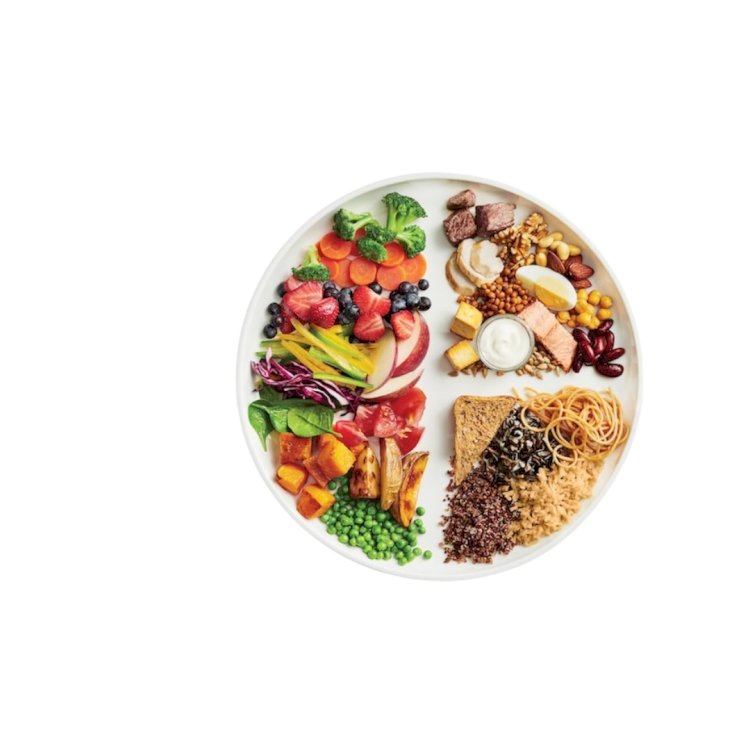Meal Planning Mistakes #2: Ignoring Proportions
Paying attention to proportions is a fundamental aspect of healthy meal planning. Rather than focusing solely on portion sizes, it is essential to consider the proportions of different foods on a plate.

As we continue on our journey through the 6 meal planning mistakes sabotaging your nutrition goals, let's discuss the importance of food proportions.
(Click here for previous blog on Lack of Variety affecting nutrition status)
Paying attention to proportions is a fundamental aspect of healthy meal planning. Rather than focusing solely on portion sizes, it is essential to consider the proportions of different foods on a plate.
As a registered dietitian, I advocate for the following proportions:
- Aim for 75% or more of the plate to be filled with plants
- Less than 25% to contain animal protein.
This balance of nutrients is beneficial for heart health, prediabetes/diabetes and weight management.
Alternatively, a 100% plant-based plate is also appropriate.
The risk of ignoring proportions when it comes to eating and meal planning:
Overeating healthy foods: Yes, even healthy foods can be overconsumed. Nuts, avocados, and whole grains are all nutrient dense, but they are also calorie dense. Consuming these in large amounts can lead to excess caloric intake, which can hinder weight loss, and even cause weight gain.
Unbalanced nutrient intake: Ignoring proportions might lead to an unbalanced diet. For example, overloading on protein while skipping on carbohydrates can leave your body without the necessary fuel for energy. Conversely, consuming too many carbs without enough protein can cause blood sugar spikes, especially problematic for those with prediabetes/diabetes.
Loss of accountability: Ignoring proportions can sometimes lead to a lack of accountability. Portion control is a tangible way to measure and track your food intake, helping you stay on course with your nutrition goals. Without it, it’s easier to lose sight of how much you’re consuming.
Finding a balanced approach can provide structure without becoming overly restrictive.
Here are some tips for achieving the right proportions:
- Allocate most of your plate (75%) to plant-based foods such as fruits, vegetables, whole grains, legumes, and nuts. These foods are rich in nutrients, fiber, and antioxidants that promote overall health.
- Limit animal protein to less than 25% of your plate. This can include lean meats, poultry, fish, eggs, or dairy products. Remember to choose lean varieties and opt for smaller portions to avoid excessive intake of saturated fats.
- Experiment with plant-based protein sources such as tofu, tempeh, lentils, beans, or quinoa. These alternatives are not only nutritious but also contribute to a more sustainable and environmentally friendly diet.
- Incorporate a variety a variety of colors and textures in your plant-based portion. Different colors signify various phytochemicals and antioxidants, so aim for a rainbow of fruits and vegetables.
- Don’t forget to include healthy fats, such as avocados, olive oil, nuts, and seeds, as a smaller portion to add flavor and satiety to your meal.
Plate method: divide your plate into sections to ensure a balanced meal. Half your plate should be filled with vegetables, a quarter with lean protein, and the remaining quarter with whole grains or starchy vegetables.
This simple approach ensures you’re getting a variety of nutrients in appropriate portions.
By focusing on proportions rather than just portion sizes, you can create a well-balanced and nutritious meal plan that supports your health goals.
Remember, the goal is to nourish your body effectively while making the journey to health enjoyable and sustainable.
Embrace portion awareness alongside nutrient dense choices, and you’ll be well on your way to achieving your nutrition goals.
Don't Miss Out--Click on the links below for more valuable nutrition health resources!
FREE Nutopia Summer Recipe Pack -- Reduce the stress of what to make with this collection of simple, delicious, healthy seasonal recipes.
FREE Guide --Tips for Blood Glucose Control --Eating healthy, being more active, and losing weight can decrease diabetes risk by 58%.
Nutopia Meal Planner for more inspiration in the kitchen with healthy, balanced recipes for breakfast, lunch, dinner, and snacks. All recipes created by dietitians with taste, health, and ease of preparation in mind!
Instagram --Follow me for more nutrition, healthy living, and recipe ideas!
Questions about how to start meal planning or making your current approach more simplified with better proportion control? Click here
Wishing you the BEST of health!
Click Here To See More














